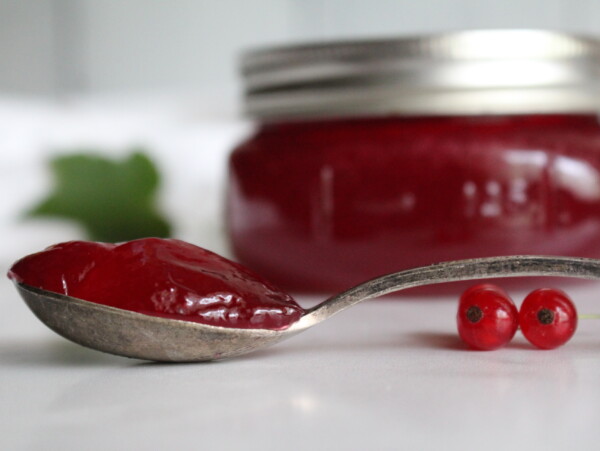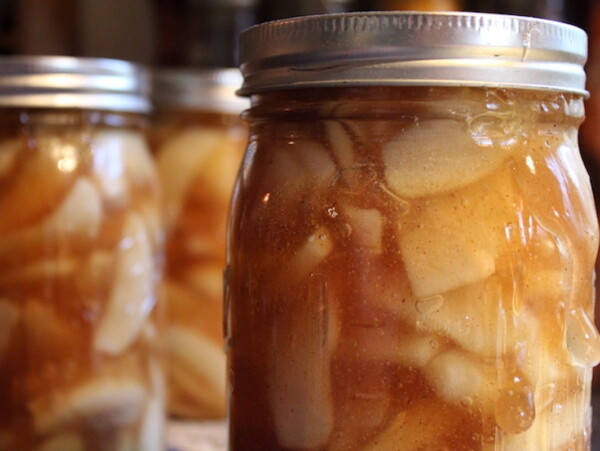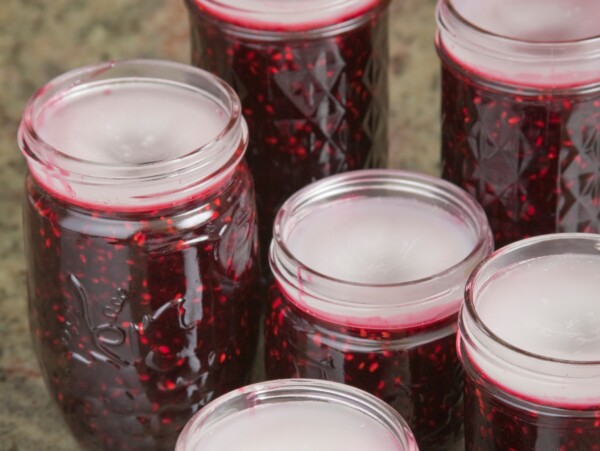This post may contain affiliate links. Please see our disclosure policy.
Preserving with wine is a simple way to elevate home-canned recipes, adding layers of flavor that survive long after the jars cool. A splash of red deepens savory sauces and meats, while white wine brightens soups and even fruit preserves. It’s perfectly safe for canning, and it can be fun to experiment with adding wine (or beer and liqueurs) to home canned goods for rich, unique flavors on your pantry shelf.

Table of Contents
- Why Use Wine in Canning Recipes?
- Substitutions for Alcohol in Canning Recipes
- Does Wine Make Food More Acidic (and Safer to Can)?
- How Alcohol Behaves During Canning
- Choosing the Right Wine for Canning
- Using Wine in Fruit Canning Recipes
- What About Beer, Brandy, and Liqueurs?
- How Much Wine to Use
- FAQ About Using Wine and Other Alcohols in Canning Recipes
Wine adds incredible depth and flavor to home-canned foods, from savory meals in a jar like Beef Burgundy and French Onion Soup to rich tomato sauces and fruit preserves. A splash of wine can elevate a recipe’s taste, lending subtle complexity without making the finished jar taste “boozy.”
But when it comes to canning, wine is about flavor—not preservation. It contributes some acidity, but not enough to replace the tested acidification required for safe water bath or pressure canning. The added acidity is there to make the flavor pop, and it does a wonderful job!
Why Use Wine in Canning Recipes?
Wine naturally contains acidity and tannins that enhance flavor while helping balance the sweetness or richness of other ingredients.
In canning recipes, wine serves the same purpose as in stovetop cooking:
- Adds depth and richness. Red wines deepen the savory notes in meat or tomato dishes.
- Balances acidity and sweetness. White wines can brighten soups, seafood, or fruit preserves.
- De-glazes and enriches sauces. When simmered with onions, meat, or vegetables, wine draws out complex browned flavors that hold up beautifully in canned meals.
Even after canning, which involves extended heat processing, wine leaves behind subtle fruity and earthy undertones that make the finished jars taste more layered and restaurant-worthy.
Substitutions for Alcohol in Canning Recipes
If you’d rather skip the wine or spirits in a canning recipe, there are plenty of easy substitutions that still deliver balanced flavor. In most cases, the alcohol is there for depth and acidity, not preservation, so replacing it won’t affect canning safety as long as you keep the rest of the recipe unchanged.
For savory recipes that call for wine, like soup canning recipes and meal in a jar canning recipes, simply use extra broth in place of the wine. If you want to mimic the slight acidity that wine adds, mix the broth with a splash of mild vinegar such as champagne vinegar, white wine vinegar, or apple cider vinegar.
A good rule of thumb is 1 tablespoon vinegar per cup of broth or water to replace wine.
For tomato-based dishes, plain water works fine too, though adding a small amount of vinegar or lemon juice can help brighten the flavor.
In sweet recipes like wine jellies or fruit canned in wine syrup, replace the wine with fruit juice (grape, apple, or pear) for a similar balance of sweetness and acidity.
These simple swaps ensure your recipes remain flavorful, balanced, and completely alcohol-free—without changing canning safety or processing times.
Does Wine Make Food More Acidic (and Safer to Can)?
Not necessarily.
Wine has a pH range of about 2.9 to 4.0, depending on the type. While that means wine is technically acidic, it’s not uniformly or reliably acidic enough to act as a tested acidifying agent in canning. The acidity varies from bottle to bottle, even among similar styles, and can change with fermentation, aging, and additives.
Because of this variability, wine cannot replace bottled lemon juice, vinegar, or citric acid when those ingredients are required for safety. The acidity of those products is standardized; the acidity of wine is not.
That said, adding wine to a tested recipe is generally safe when it’s used in place of part (or all) of the water, broth, or other liquid—as long as the original recipe already meets canning safety guidelines.
For example:
- In Canning Tomatoes in Red Wine, the wine replaces the packing liquid but not the required lemon juice for acidification.
- In Beef Burgundy, the red wine is part of the broth mixture, but the recipe still follows pressure canning guidelines for low-acid foods.
- In French Onion Soup, a small amount of dry white wine adds balance to the broth without changing acidity requirements.
- In Chicken Marsala and Coq au Vin, the wine is essential to the sauce, creating rich depth of flavor that stands up beautifully to pressure canning while still meeting all safety standards for low-acid meals in a jar.
The main point here is that wine adds flavor, not food safety. You still need the correct acidification for the type of recipe you’re canning.
How Alcohol Behaves During Canning
During cooking and processing, most of the alcohol evaporates. Heat causes alcohol to burn off rapidly, leaving behind only trace amounts—along with the complex flavors it carried from the wine or spirit.
By the time a canning recipe is simmered, ladled into jars, and processed in a boiling-water bath or pressure canner, the residual alcohol is minimal. What remains are the flavorful acids, sugars, and tannins that enrich the finished preserve.
So from a food-safety standpoint, alcohol is safe in canning recipes—it doesn’t interfere with sealing or preservation, and it doesn’t pose a risk to food safety.
Sometimes, alcohol is added right before canning, and the goal is to preserve the alcohol in the finished product. Something like brandied pears is a great example, as is my recipe for canning blackberries that uses a bit of framboise liqueur for both flavor and fun boozy notes.
And that’s perfectly fine too! You don’t have to cook the alcohol off if you don’t want to, either way is perfectly safe for canning.
Choosing the Right Wine for Canning
If a canning recipe calls for wine and doesn’t specify which kind, choose something dry, not sweet, unless you’re making a dessert preserve.
For Savory Recipes
- Dry Red Wines: Cabernet Sauvignon, Merlot, Malbec, or Pinot Noir are excellent for rich, tomato-based sauces, beef dishes, or venison.
- Dry White Wines: Sauvignon Blanc, Pinot Grigio, or unoaked Chardonnay work beautifully in soups, seafood dishes, and vegetable recipes.
For Sweet or Fruit Recipes
- Sweet Whites: Moscato, Riesling, or Gewürztraminer can complement fruit preserves or syrups.
- Sparkling Wines: Used in small amounts in jellies or fruit fillings, they add subtle floral notes.
For Neutral Flavor
If you don’t drink wine often, buy a small 4-pack of mini bottles—that way you can choose the right style without wasting a full bottle. Cooking wines sold in grocery stores are heavily salted and often poor quality; stick to real drinkable wine, even if inexpensive.
Using Wine in Fruit Canning Recipes
Wine also works beautifully in high-acid fruit preserves. Because these recipes are already safe for water bath canning, you can experiment more freely with flavor pairings.
- Canning Pears in White Wine Syrup: Combine white wine, sugar, and a touch of vanilla or cardamom for a fragrant syrup.
- Canning Peaches in Moscato or Riesling: Sweet wines complement the natural sugars in the fruit and create a light, aromatic syrup.
- Wine Jellies: Use red, white, or sparkling wine with pectin and sugar for a gourmet preserve that pairs perfectly with cheese.
In these cases, the wine replaces part or all of the syrup liquid, and the recipe remains safely high in acid. Brandied fruits (like brandied pears) are also common, and liqueurs are perfectly fine too. In many cases, they’re not adding acidity, but that’s not necessary in most fruit canning recipes.
What About Beer, Brandy, and Liqueurs?
Though wine is most common, many traditional canning recipes include other alcoholic ingredients for flavor:
- Brandy or Whiskey: Often added to jams, marmalades, or fruit butters near the end of cooking. The alcohol evaporates during simmering, leaving a subtle warm flavor. Whiskey Maple Pear Butter is absolutely delicious!
- Liqueurs (such as Grand Marnier, Chambord, or Amaretto): Used in small amounts in fruit jams or jellies for a dessert-like finish, and they’re chosen to complement the fruits in the recipe. (ie. Amaretto in cherry recipes or chambord in berry recipes)
- Beer or Ale: Occasionally found in savory recipes like chili base or barbecue sauce for canning; use dark, malty beers for depth and cook thoroughly before processing.
All of these are safe for canning when used as flavoring ingredients. The alcohol content doesn’t interfere with sealing, and the heat of processing removes any residual alcohol.
How Much Wine to Use
In most tested canning recipes, wine replaces up to one-third of the liquid in a recipe. In stronger recipes, like Beef Burgundy, it may make up half or more of the cooking liquid.
If you’re adapting a tested recipe, you can safely replace some or all of the broth or water with wine, provided you:
- Don’t alter other ingredients or proportions affecting acidity or density.
- Maintain proper processing method (pressure canning for low-acid foods).
- Keep headspace and jar sizes the same.
Wine in canning recipes adds elegance and flavor that truly stand out on the pantry shelf. Whether it’s a rich red wine in Tomato Basil Pasta Sauce, a crisp white in Seafood Chowder Base, or a sweet Riesling in Pear Preserves, the wine infuses each jar with subtle character and depth.
Just remember: wine enhances flavor but doesn’t ensure safety. Always follow tested recipes and required acidification for your canning method. When used properly, wine and other spirits can make your home-canned foods taste like they came straight from a French bistro—without compromising shelf stability.
FAQ About Using Wine and Other Alcohols in Canning Recipes
Yes! Wine is safe to use in both water bath and pressure canning recipes when included as part of the tested liquid ingredients. It adds flavor and complexity, but it’s not a preservative or acidifier, so you still need to follow all standard canning safety guidelines.
No. You can replace water or broth with wine, but never substitute it for the acidifiers that are required for safe canning. Those ingredients have standardized acidity levels that ensure your jars are shelf stable.
For savory recipes, choose a dry wine like Sauvignon Blanc, Pinot Grigio, Merlot, or Cabernet Sauvignon. For desserts or fruit preserves, use a sweet white such as Riesling, Moscato, or Gewürztraminer. Always avoid “cooking wines,” which contain added salt and preservatives.



